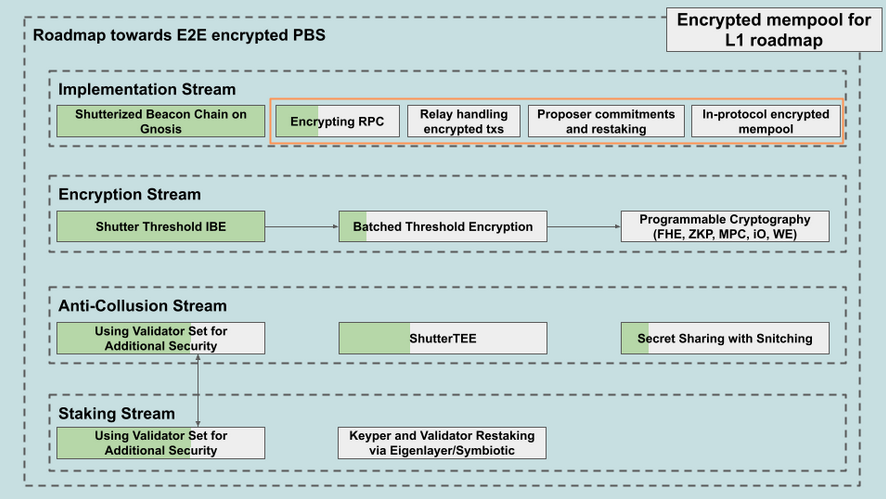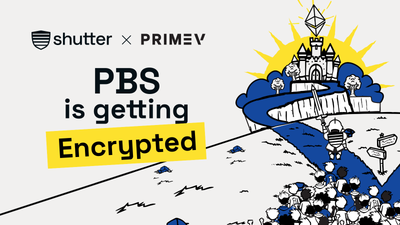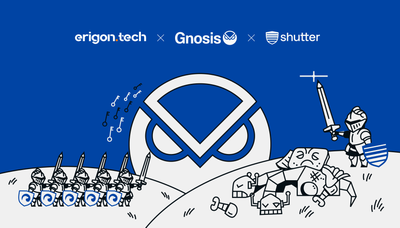We are excited to announce the release of "The Road Towards a Distributed Encrypted Mempool on Ethereum," a white paper that outlines an essential advancement in Ethereum's transaction infrastructure.
This research is now available on the Ethresearch forum and presents a structured roadmap for implementing threshold encrypted mempool. This approach fundamentally changes how transactions are managed before being included in a block.
This collaborative proposal aims to virtually eliminate malicious MEV (Maximal Extractable Value) exploitation and information asymmetry, and dramatically reduce real-time censorship by encrypting transactions before they reach validators. This approach addresses long-standing issues that have affected Ethereum's transaction supply chain. Importantly, Shutter's technology is already operational on Gnosis Chain, showcasing how this is a viable model, and we are currently exploring how a similar approach could be implemented on Ethereum.
A key component of this roadmap is the implementation of proposer commitments. This mechanism requires validators to commit to including encrypted transactions before they are decrypted. By integrating proposer commitments into Ethereum's existing Proposer-Builder Separation (PBS) architecture, we can establish a more censorship-resistant, private, and equitable transaction environment. This setup prevents validators from selectively excluding or reordering transactions for profit.
We are excited to announce our collaboration with Nethermind, Gnosis, Chainbound, and MEV Blocker (CoW Protocol) on the white paper titled "The Road Towards a Distributed Encrypted Mempool on Ethereum." This initiative transcends standard MEV mitigation proposals; it lays out a vision for an Ethereum network that serves the interests of everyone rather than just those with privileged access to mempool data.
This blog post will summarize the key insights from the white paper, explaining the significance of encrypted mempools, the role of proposer commitments in the roadmap, and the potential future of transactions that are both censorship-resistant and private.
Why Transparency in Transactions Creates an Unfair Game
Imagine playing Rock, Paper, Scissors with a friend. The game only works if both players reveal their choices at the same time. But what if your opponent could see your move five seconds before making their own? In that case, they would always win.
This scenario illustrates how MEV functions today. Every Ethereum transaction is visible prior to execution, allowing those with the right tools to gain an unfair advantage. When traders broadcast their orders, they are not merely participating in an open market; they are entering a game where some players already know their strategies.
Shutter's encrypted mempool enhances fairness by keeping transactions confidential until they are finalized. No one—not even validators—can access them before this point. The result is a financial system where all participants adhere to the same rules.
Why Does Ethereum Need an Encrypted Mempool?
Ethereum's transaction supply chain has become more fragmented and complex, especially with the introduction of Proposer-Builder Separation (PBS), which adds multiple intermediaries between users and validators. Additionally, private mempools have surfaced as a solution to concerns about front-running and censorship. However, these private mempools bring their own trust assumptions and lack of transparency, which can compromise Ethereum's neutrality.
Currently, transaction flow is controlled by centralized block builders, relays, and order flow auctions. This creates a situation where users must navigate a complicated network of intermediaries to ensure their transactions are processed. Although these solutions aim to enhance efficiency, they also increase complexity, introduce new risks of centralization, and do not address fundamental issues regarding privacy and censorship at the base layer.
A distributed encrypted mempool simplifies the transaction supply chain of Ethereum while preserving its permissionless and decentralized nature. By encrypting transactions at the mempool level, Ethereum can eliminate dependence on private mempools, ensure fair inclusion, and reduce the increasing influence of centralized builders and relays in transaction execution.
Before we explore the technical details, let’s pause to consider the broader context.
Why Censorship Resistance Matters
Three blockchain-related companies under the Sony Group have recently launched Soneium, a Layer 2 blockchain built on Optimism's OP Stack. However, the platform faced immediate backlash due to its decision to denylist specific smart contracts, which resulted in the freezing of some assets and left users unable to conduct transactions.
Here's the key point: While Layer 2 chains benefit from Ethereum's censorship resistance at the base layer—allowing users to revert to submitting transactions via Layer 1—this does not guarantee real-time censorship resistance. In the case of Soneium, transactions were blocked at the Layer 2 level, preventing users from acting immediately and resulting in financial losses.
This situation highlights a critical issue: when censorship occurs at the transaction execution layer, even Ethereum's neutrality cannot prevent disruptions. It is essential to ensure censorship resistance before transactions are finalized. In this context, an encrypted mempool on Ethereum can play a vital role.
Shutter's encrypted mempool guarantees that no single entity—not even validators—can selectively filter transactions. Censorship involves not only blocking transactions but also determining who can access them in the first place.
How Shutter's Encryption Works
The Ethereum public mempool poses a dual challenge: it offers transparency while enabling MEV extraction, front-running, and potential censorship. Shutter has implemented threshold encryption to ensure transaction confidentiality until they are finalized on-chain. Here’s how the process works:
- A distributed set of node operators (Keypers) generates an encryption key.
- Users encrypt their transactions before submitting them.
- Transactions remain hidden while being ordered in the mempool.
- The decryption key is revealed once a block is sealed and transactions are executed.
This model eliminates the ability of MEV actors to extract value unfairly while maintaining Ethereum's decentralized and permissionless characteristics. It also allows for back-running MEV, which can still be extracted and distributed, keeping systems efficient and profitable.
The Path to Ethereum Integration
Integrating an encrypted mempool into Ethereum necessitates a structured, phased approach. The white paper details three essential steps for incorporating threshold encryption into Ethereum's transaction supply chain:
The Three Steps
- RPC-Level Encryption: The first step involves the introduction of an encrypted RPC endpoint, which allows users to submit encrypted transactions without altering Ethereum's base protocol. This method offers immediate protection against transaction visibility while facilitating gradual adoption. It empowers developers and wallet providers to integrate encryption without making significant changes to the existing infrastructure.
- Proposer Commitments in PBS: The second step enhances Ethereum's existing Proposer-Builder Separation (PBS) by introducing proposer commitments. In this model, validators commit to including encrypted transactions before they can view their contents. This approach ensures that transactions remain private while still being ordered and included in blocks. It helps address censorship risks and reduces information asymmetry.
- Full Protocol Integration: The final step integrates encrypted transactions directly into Ethereum's consensus layer. With this update, all transactions will be encrypted by default, and the decryption process will be enforced at the protocol level. This change will represent a fundamental shift in Ethereum's architecture, ensuring that transaction privacy and censorship resistance are inherent features of the network.
Each phase represents a significant milestone, continuously improving transaction fairness while adapting to the evolving infrastructure of Ethereum. By utilizing proposer commitments, this integration aligns with Ethereum's long-term vision and ensures compatibility with the existing builder-proposer model.
The idea of an encrypted mempool is not merely theoretical; it has already been implemented on the Gnosis Chain. This demonstrates that transactions can remain private until they are finalized. Real-world applications have shown that encrypted mempools effectively conceal transaction details while maintaining a decentralized and efficient execution environment.
However, implementing this on Ethereum presents additional challenges due to its more complex Proposer-Builder Separation (PBS) architecture. Ethereum relies on a fragmented supply chain of builders, relays, and proposers, making the integration of an encrypted mempool more difficult.
To address this, we propose using proposer commitments. This mechanism ensures that validators commit to including encrypted transactions before they are decrypted. This approach:
- This proposal builds on Ethereum's existing Proposer-Builder Separation (PBS) model, ensuring compatibility with the current methods of block construction.
- It prevents validators from selectively excluding transactions, which reinforces Ethereum's neutrality and resistance to censorship.
- Additionally, it ensures fair transaction processing, offering a trust-minimized alternative to the current reliance on private mempools.
If implemented, this would mark the first-ever use of proposer commitments on Ethereum, a critical step toward simplifying its transaction supply chain while maintaining the security and decentralization that make the network resilient.
A Collaborative Effort to Make Ethereum Fairer
This vision for an encrypted mempool is not just theoretical; it represents an active, collaborative effort among multiple teams.
- Gnosis focuses on censorship resistance and decentralized block production, building on previous work with the Shutterized Beacon Chain and supporting the integration of threshold encryption into Ethereum's Proposer-Builder Separation (PBS) model.
- Chainbound is spearheading efforts regarding proposer commitments, a mechanism that ensures validators agree to include encrypted transactions before they are decrypted. This strengthens the fairness and transaction integrity of Ethereum.
- MEV Blocker (CoW Protocol) is integrating Shutter’s encryption into its private transaction routing system to enhance user protection against front-running and censorship during transaction submission.
- Nethermind is developing an Ethereum client-side implementation and has integrated Shutter's encrypted mempool on the Gnosis Chain. It is now examining how Fork-Choice Enforced Inclusion Lists (FOCIL) can strengthen transaction inclusion guarantees alongside proposer commitments.
By working together, these projects are laying the groundwork for a privacy-first Ethereum that protects all participants—not just those with privileged access to mempool data.
A Roadmap for Ethereum's Future
The Ethereum mempool does not need to remain in a broken state. MEV is siphoning value from users and negatively affecting the overall experience on the Ethereum network. The centralization of builders is undermining the principle of neutrality that Ethereum upholds, putting the platform's decentralized nature at risk.
Shutter's encrypted mempool is both a theoretical concept and a proven solution. The main challenge now is integrating it into Ethereum.
This long-term roadmap has already been successfully tested on the Gnosis Chain. The next step is to expand this solution to Ethereum and beyond.
Are you ready for a privacy-first Ethereum?
Let's build it together.
Learn More
📖 Read the full white paper at Shutter Docs

💬 Join the discussion on Ethresearch

Join the Community!
Follow us on X-Twitter, visit the Shutter Forum, and join our community on Shutter Discord to learn more about how Shutter works and stay updated on our progress.









